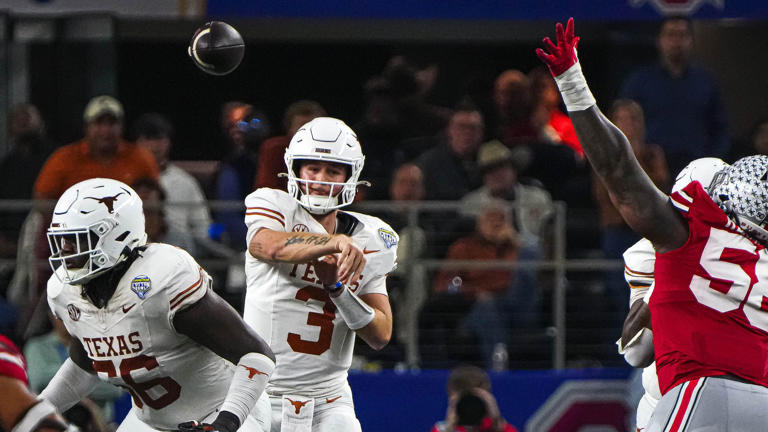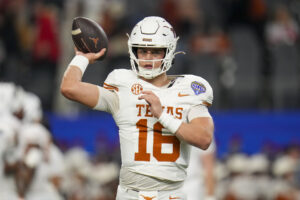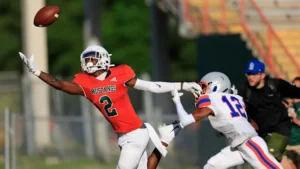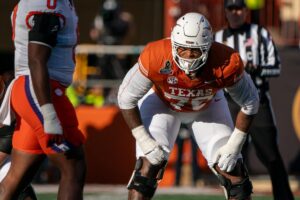
Quinn Ewers: Navigating the NFL Draft Landscape – A Texas Star’s Projections
As the 2025 NFL Draft approaches, the football world is abuzz with speculation about where the nation’s top collegiate talents will land. Among the most intriguing prospects is Quinn Ewers, the former highly-touted quarterback of the Texas Longhorns. After three seasons in Austin, marked by both flashes of brilliance and periods of inconsistency, Ewers has declared for the draft, leaving behind a legacy that includes leading the Longhorns to consecutive College Football Playoff appearances and ranking third in school history for both passing yards (9,128) and touchdowns (68). However, the question remains: where will Ewers be selected, and what does the future hold for him in the NFL?
Ewers’ draft stock has been a subject of considerable debate among analysts and scouts. Once considered a potential first-round pick, projections have become more varied as the draft draws nearer. Several factors contribute to this uncertainty. On the one hand, Ewers possesses undeniable physical tools. At 6-foot-2 and 214 pounds, he has prototypical size for an NFL quarterback. Scouts have lauded his arm talent, noting his ability to generate velocity from various arm angles and his quick release, particularly when throwing in rhythm. He has also demonstrated the capacity to make impressive throws on the move, showcasing playmaking ability outside of structured plays. Furthermore, his deep-ball accuracy has been highlighted, evidenced by his 24th-best deep passing grade in the FBS last season.
However, concerns exist regarding other aspects of his game. A significant criticism revolves around his consistency under pressure. Despite playing behind a strong Texas offensive line, Ewers displayed a tendency to abandon clean pockets, leading to unnecessary pressure and sacks. His pocket awareness has been described as inconsistent, with instances of both escaping pressure effectively and being unaware of impending hits. Additionally, his completion percentage (62.7% last season) has been noted as one of the lowest among top quarterback prospects, and he has a tendency to rely on his initial reads, sometimes struggling to progress through multiple options and resorting to check-downs.
NFL draft analysts have offered a range of potential landing spots for Ewers, reflecting the divergent opinions on his current skill set and potential. Some projections place him as a Day 2 pick, suggesting teams might view him as a developmental prospect with high upside. The Seattle Seahawks have been frequently mentioned as a possible destination in the second or third round, with the idea that Ewers could develop behind Geno Smith and become a future starter. Other teams like the New Orleans Saints, potentially looking for a successor to Derek Carr, and the Miami Dolphins, who might seek more durability at the quarterback position, have also been cited as potential fits.
Interestingly, some analysts have even suggested a Day 3 selection for Ewers. ESPN’s Ben Solak, for instance, projected him to the Dallas Cowboys in the sixth round, suggesting he might initially serve as a backup. This projection highlights the view that while Ewers possesses intriguing physical traits, he needs significant development in his decision-making, pocket presence, and overall consistency to become a reliable NFL starter.
Historically, the Texas Longhorns have a rich tradition of producing NFL talent, including several quarterbacks. While few Longhorn quarterbacks have been drafted in the very early rounds, players like Bobby Layne and Vince Young were high selections who achieved varying levels of NFL success. More recently, Colt McCoy, drafted in the third round in 2010, carved out a long career as a capable backup. Ewers’ draft trajectory appears to align more closely with quarterbacks like McCoy, who entered the league with potential but needed refinement.
Ultimately, where Quinn Ewers is drafted will depend on how NFL teams weigh his raw talent against his areas for improvement. Teams with established quarterbacks might be more willing to invest a Day 2 or 3 pick in Ewers, hoping to develop his skills over time. Conversely, teams with immediate needs at the position might be hesitant to spend a high pick on a player who is still considered a developmental prospect by some. Regardless of where he lands, Ewers’ NFL journey will be closely watched to see if he can harness his potential and become the impactful player many envisioned during his high school career. His blend of arm talent and playmaking ability offers an enticing package, but his ability to refine his decision-making and consistency will be crucial in determining his success at the professional level.





